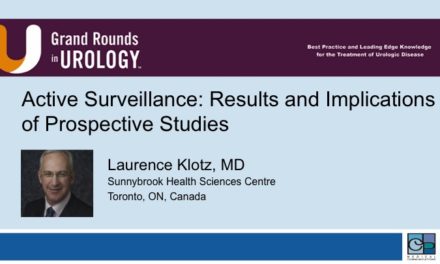
PCa Commentary | Volume 127 – October 2018
Posted by Edward Weber | October 2018
DECIPHER AND A HYBRID CLINICAL – GENOMIC CLASSIFIER:
Improving the Prognostic Accuracy of NCCN Risk Categories
The conventional National Cooperative Cancer Network (NCCN) risk categories — low-, intermediate-, and high-risk — are largely based on the Gleason score as determined by the microscopic appearance of cells and their organization. However, beneath the surface appearance lies a heterogeneity of biologic behavior that is only now being captured by genomic analysis. The NCCN groupings have been expanded by subtyping intermediate-risk into favorable and unfavorable, and also by including the percent of positive cores. Even so, there remains a significant need for further prognostic accuracy. This is now being addressed by the commercially available gene-expression classifiers, such as OncotypeDx, Prolaris, and Decipher. These gene panels are designed to capture the unrecognized nuances of biologic behavior.
This Commentary has chosen Decipher as an example as, with over 40 publications, it has the most data to support its use. The article will discuss how Decipher is constructed, its benefits as a supplement to the standard risk assessments tools, and offer examples of its use in clinical practice. Additionally, the Commentary will highlight the work of Dr. Dan Spratt and colleagues that integrates the NCCN system with Decipher to achieve further prognostic accuracy (“Spratt, et al., Journal of Clinical Oncology, Feb. 2018”).
What is Decipher?
Decipher is an assemblage of 22 regulatory genes that associate with tumor aggressiveness (GenomeDx Biosciences, Inc). On the basis of the combinatorial expression of these genes in a particular tumor, its biological behavior can be assessed and predicted with considerable accuracy. The work underlying Decipher was first presented in PLOS ONE by Ergo, et al. in June 2013. The 22-gene panel was originally optimized to predict a man’s risk of developing metastatic disease.
The Decipher test became commercially available in 2013. Further refinement of the assay predicts for the likelihood of metastases in 10 years and can be performed on biopsy or a whole gland specimen. In 2017, Nguyen and colleagues presented “the first demonstration of the ability of the biopsy-based GC [Decipher] score to predict for distant metastases after definitive radiation and ADT for intermediate-and high-risk cancer,” (Prostate Cancer and Prostatic Diseases).
“Previous studies of Decipher demonstrated that patients in the intermediate and high risk Decipher groups are at a twofold and sevenfold higher risk, respectively, for metastases than patients at low risk” (Klein, et al., J Urol, Jan. 2017).
Decipher is listed in the NCCN Guidelines Version 2.2017 as an available tissue-based test for estimating prostate cancer prognosis. It is now covered by Medicare and also by many insurance programs for high-risk cancer and for a PSA rising above nadir. If not covered by insurance, the out-of-pocket cost is ~$4000, but there is ongoing work to provide these tests for <$1000 as a direct-to-consumer product.
Decipher assesses the RNA expression of genes for cell proliferation, cell differentiation, cell structure, cell adhesion and mobility, cell cycle progression, mitosis, and immune response.
The test stratifies the 10-year risk for metastases on a continuous risk score of 0 – 1 with <0.45, low; 0.4.5 – 0.6, intermediate; and >0.6 as high.
Examples of Decipher in clinical practice:
➢ Decipher has been used in the challenging decision regarding adjuvant or salvage
radiotherapy following a prostatectomy in locally advanced disease, i.e. positive surgical margins, extracapsular extension, or seminal vesicle involvement. Current practice tends to track the post operative PSA and offer radiation upon the development of an (increasingly) minimal rise above undetectable, i.e. possibly at PSA 0.2 ng/mL— or even lower. Decipher has been shown to identify those men who are genomically destined to exhibit an early postoperative PSA rise — men who might benefit from immediate radiation.
➢ At ASCO GU 2018, John L. Gore, MD, presented data regarding 517 men with locally
advanced cancer at prostatectomy. In one third of the men, based on the Decipher score, the initial treatment plan for adjuvant or salvage radiation was changed.
➢ “Molecular Analysis of Low Grade Prostate Cancer Using a Genomic Classifier [Decipher]
for Metastatic Potential,” examined “how frequently histologic Gleason 3 + 3 = 6 tumors had the molecular characteristics of disease with metastatic potential” ((Klein, et al., above, ibid). Their examination of specimens from 269 men found that intermediate and high Decipher scores were found in 13% and 7% respectively, information that might help guide the selection of men for active surveillance.
The new integrated clinical-genomic risk group classification presented in the Spratt JCO 2018 article:
An important feature of the Decipher assay is the prediction of likelihood of developing the clinically significant end-points of distant metastases at 10 years and prostate cancer-specific mortality. The development of distant metastases is now accepted as a surrogate for both prostate cancer survival and overall survival. In contrast, the NCCN and D’Amico risk groups predict for a patient’s pretreatment likelihood for biochemical recurrence, a measurement “not optimized for survival outcomes” (Spratt, et al., ibid).
Treatment decisions are regularly made daily by clinicians on the basis of the NCCN clinical/pathological risk-groups, i.e., low-, favorable and unfavorable intermediate-, and high-risk categories. Examples of frequent real-life clinical decisions are: active surveillance to be suggested or not, and adjuvant hormone therapy to be recommended or not.
The thrust of the effort by the researchers in the JCO article was to acknowledge the prognostic deficiencies that tumor heterogeneity imposes within the NCCN groupings, and sharpens them by integration with genomic- based information based on Decipher. The product of their extensive analysis was a 6-tier clinical/genomic (CG) classifier to predict the likelihood of distant metastases in 10 years and a 3-tier model for use in clinical trials. The goodness of fit of their models was validated prospectively in two cohorts of 5937 men who had had a prostatectomy.
How to assign points in the integrated NCCN and Decipher systems to achieve the 6-point clinical-genomic categories:; wWhat outcomes are predicted,; and what to do with the estimated prognosis?
The method is quite straightforward. Answer: sSum the points assigned to each risk level in each of the two systems.
The four risk categories of the NCCN schema are each assigned points as follows: low, 0 points;, fav-int, 1 point;, unfav-int, 2 points;, and high, 3 points.
Correspondingly: Decipher <0.45, 0 points; Decipher 0.45 – 0.6; 1 point; and high Decipher >0.6, 2 points.
The various combinations of the summed points from the two systems results in a 6-tier schema of 0 – 5 total points
The outcome for the 6-tier classifier is a nicely- graded prognostic span for the likelihood of metastases in 10 years: 0 points, 3.1%; 1 point, 3.7%; 2 points, 25.9%; 3 points, 31.7%; 4 points, 49.7%; and 5 points, 61.9%. These figures will require further strengthening with additional data since at this time the confidence limits are fairly wide.
The simplified 3-tier system was developed for clinical trials. It compresses the 6-tier model into three tiers yielding 10-year prognoses for metastases as follows: low, 3.5%; intermediate, 29.4%; and high, 54.6%.
The final task for the patient and clinician, after calculating the percentage risk for metastases, is to jointly develop a treatment plan that takes the risk prognosis into consideration in relation to the benefits and downside of a proposed regimen.
Examples of reclassification from the NCCN system into the 6-tier clinical- genomic classification model:
In prospective cohort II in the Spratt study, 29.9% (292/977) of men based on their biopsy 4-tier NCCN risk assignment were reclassified in the 6-tier model.
➢ 17.1 % of men initially classified as NCCN low-risk were reclassified to favorable
intermediate, i.e. Gleason 3 + 4 = 7, potentially making them ineligible for active surveillance in most schemas. This percentage of reclassification parallels the documented likelihood that 20 – 30% of men with initial biopsy Gleason score 6 are found on confirmatory biopsy to be Gleason 7.
➢ 54% of men initially NCCN favorable-risk were reclassified to unfavorable risk, a change likely to affect the decision whether to add adjuvant hormone treatment after radiation therapy. [See study cited below.] And, 44.4% of men in the favorable NCCN group were reassigned to low risk in the GC system.
Lastly; an example of the CG risk classifier in clinical practice:
In a study of 121 men with NCCN intermediate-risk prostate cancer (IR-PCa) treated with radiation and no ADT between 2005 – 2011, Berlin et al. (Int J Rad Oncl Bio Phys., June 2018 June) retrospectively evaluated biopsy specimens with the CG classifier (Int J Rad Oncol Biol Phys. June 2018). Their quest was to determine whether the NCCN or GC classification better predicted for 5-year biochemical recurrence and metastases. Using the two current NCCN two subcategories of intermediate-risk cancer, 60 of 87 men initially staged as NCCN unfavorable-risk were reclassified to favorable and 3 of 33 favorable-risk were assigned unfavorable status on the basis of their CG scores.
Their finding was that the CG model performed significantly better than NCCN in predicting these end points. The clinical-genomic model was almost 90% accurate at predicting metastases. Their conclusion: “We therefore recommend the use of clinical-genomic risk stratification to identify IR-PCa patients who can be treated with DE-IGRT [dose-escalated image-guided radiation therapy] and safely omit combinatorial ADT.”
BOTTOM LINE:
The NCCN risk categories incompletely capture the disparity of biologic behavior within each group. By integrating Decipher with the NCCN system, a clinical-genomic classifier has been developed which substantially improves prognostic accuracy.
References:
- Spratt, et al., “Development and Validation of a Novel Integrated Clinical-Genomic Risk Group Classification for Localized Prostate Cancer.” Journal of Clinical Oncology. Feb. 2018.
- Ergo, et al., “Discovery and Validation of a Prostate Cancer Genomic Classifier that Predicts Early Metastasis Following Radical Prostatectomy.” PLOS ONE. June 2013.
- Nguyen, et al. “Utilization of biopsy-based genomic classifier to predict distant metastasis after definitive radiation and short-course ADT for intermediate and high-risk prostate cancer.” Prostate Cancer and Prostatic Diseases. 2017.
- Klein, et al., “Molecular Analysis of Low Grade Prostate Cancer Using a Genomic Classifier of Metastatic Potential.” J Urol, Jan. 2017.
- Berlin, et al., Int J Rad Oncol Biol Phys. June 2018.
Your comments and requests for information on a specific topic are welcome e-mail ecweber@nwlink.com. Please also visit https://prostatecancerfree.org/prostate-cancer-news for a selection of past issues of the PCa Commentary covering a variety of topics.
“I want to thank Dawn Scott, Staffperson, Tumor Institute Radiation Oncology Group, & Mike Scully, Librarian, Swedish Medical Center for their unfailing, timely, and resourceful support of the Commentary project. Without their help this Commentary would not be possible.”
ABOUT THE AUTHOR
Edward Weber, MD, is a retired medical oncologist living in Seattle, Washington. He was born and raised in a suburb of Reading, Pennsylvania. After graduating from Princeton University in 1956 with a BA in History, Dr. Weber attended medical school at the University of Pennsylvania. His internship training took place at the University of Vermont in Burlington.
A tour of service as a Naval Flight Surgeon positioned him on Whidbey Island, Washington, and this introduction to the Pacific Northwest ultimately proved irresistible. Following naval service, he received postgraduate training in internal medicine in Philadelphia at the Pennsylvania Hospital and then pursued a fellowship in hematology and oncology at the University of Washington.
His career in medical oncology was at the Tumor Institute of the Swedish Hospital in Seattle where his practice focused largely on the treatment of patients experiencing lung, breast, colon, and genitourinary cancer and malignant lymphoma.
Toward the end of his career, he developed a particular concentration on the treatment of prostate cancer. Since retirement in 2002, he has authored the PCa Commentary, published by the Prostate Cancer Treatment Research Foundation, an analysis of new developments in the prostate cancer field with essays discussing and evaluating treatment management options in this disease. He is a regular speaker at various prostate cancer support groups around Seattle.




